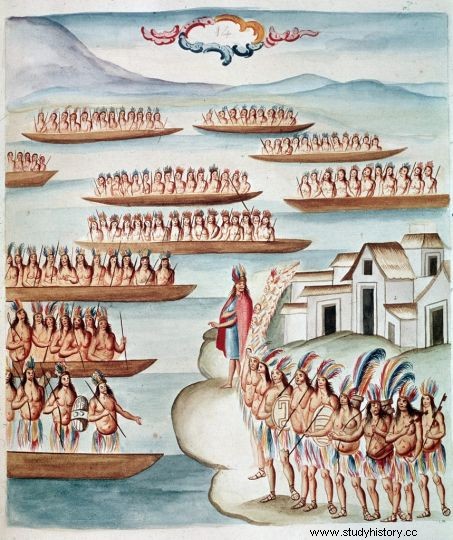For the first time, the origin of the victims of the Mexican human sacrifices of the 14th century, could be determined thanks to isotopic analyses. Information that has remained uncertain until now.

Codex Florentino:Enslaved Adults and Children in Aztec/Mexica Society,
In Tenochtitlan (present-day Mexico City), in 1354, vultures circled in the sky above the thousands of human skulls of Huey Tzompantl i. This is the name given to the macabre abacus, 30 meters long, flanked on either side by two imposing towers of skulls. These exhibited heads were meant to honor the insatiable deities of Huei Teocali , the Templo Mayor des Mexica, another name for the Aztecs:the 45-meter-high double pyramid dedicated to Huitzilopochtli, god of the sun and war, on the south side, and that of Tlaloc, god of rain and fertility, on the south side. north. But where did these countless heads of men, women and children come from? Were they slaves, the tlatlacotin bought on specialized markets? Warriors captured in combat? From Mexica themselves? Strangers? And above all, does science today make it possible to answer such questions?

Thousands of human skulls were found between 2015 and 2018 at the site of ancient Tompantzli in the Aztec capital of Tenochtitlan, present-day Mexico City. Credits:Raul Barrera Rodriguez/INAH
Isotopic analyzes of the oxygen of phosphates on several remains of sacrifices
In an article published in the journal Journal of Anthropological Archaeology, an international team of researchers details how they managed to obtain initial results, by carrying out isotopic analyzes of the oxygen of phosphates on several remains of sacrifices.
In Tenochtitlan (present-day Mexico City), in 1354, vultures circled in the sky above the thousands of human skulls of Huey Tzompantl i. This is the name given to the macabre abacus, 30 meters long, flanked on either side by two imposing towers of skulls. These exhibited heads were meant to honor the insatiable deities of Huei Teocali , the Templo Mayor des Mexica, another name for the Aztecs:the 45-meter-high double pyramid dedicated to Huitzilopochtli, god of the sun and war, on the south side, and that of Tlaloc, god of rain and fertility, on the south side. north. But where did these countless heads of men, women and children come from? Were they slaves, the tlatlacotin bought on specialized markets? Warriors captured in combat? From Mexica themselves? Strangers? And above all, does science today make it possible to answer such questions?

Thousands of human skulls were found between 2015 and 2018 at the site of ancient Tompantzli in the Aztec capital of Tenochtitlan, present-day Mexico City. Credits:Raul Barrera Rodriguez/INAH
Isotopic analyzes of the oxygen of phosphates on several remains of sacrifices
In an article published in the journal Journal of Anthropological Archaeology, an international team of researchers details how they managed to obtain initial results, by carrying out isotopic analyzes of the oxygen of phosphates on several remains of sacrifices.
"This method consists of analyzing the isotopic composition of the phosphate oxygen atoms present in bone apatite - the mineralized tissues of bone and tooth enamel" , explains Elise Dufour, from the archaeozoology, archaeobotanical practical environmental society laboratory of the National Museum of Natural History (UMR 7209 of the CNRS), who did not participate in this work. The study of these elements incorporated into human tissues via water ingested during life, makes it possible to identify geographical origins, knowing that the composition of water varies according to location and multiple environmental factors. .
Analyzes of bones and tooth enamel taken from 36 victims of the "Templo Mayor" of Tenochtitlan as well as 24 other individuals from "Temple R" in the city of Tlatelolco, several kilometers away, were compared with those of contemporary groups present in the region of Ecatepec, another city in the basin of Mexico.

View of the city of Tlatelolco, on the edge of the Mexico City lagoon. A watercolor by Diego Garcia Panes (1736-1811). Credits:Luisa Ricciarini / Leemage / AFP
The victims were meticulously selected by the priests
"The results collected allow us to say that at the Tlatelolco site, the people sacrificed were either locals or long-time residents who had lived in the town “, explains the archaeologist Leonardo Lopez Lujan, signatory of the article. In contrast, the sacrificed teenagers of the Templo Mayor, in Tenochtitlan, were foreigners and the adults, rather residents. “Probably slaves living there for a long time ", estimates the archaeologist. Information which confirms what the Spanish chronicler Diego Duran had mentioned in the 16th century. In his memoirs, the monk indicated that they were often criminals or gamblers. And sometimes even teenagers sold by their own families in difficulty... There were also people from other territories, war captives sacrificed shortly after their arrival.

Mexica high priests in ceremonial costumes. Florentine Codex by Bernardino de Sahagun (1569-1575). Credits:AFP
"The priests of the Templo Mayor had access to a human reservoir of longtime residents as well as foreigners captured in Mesoamerican areas under Mexica control ", concludes the study. The tortured were meticulously selected by the priests according to their physique, the type of ceremonies and the particular deities for which they were destined. This study brings to light for the first time the diversity of social and geographical identities victims of the human sacrifices of the Aztecs.
